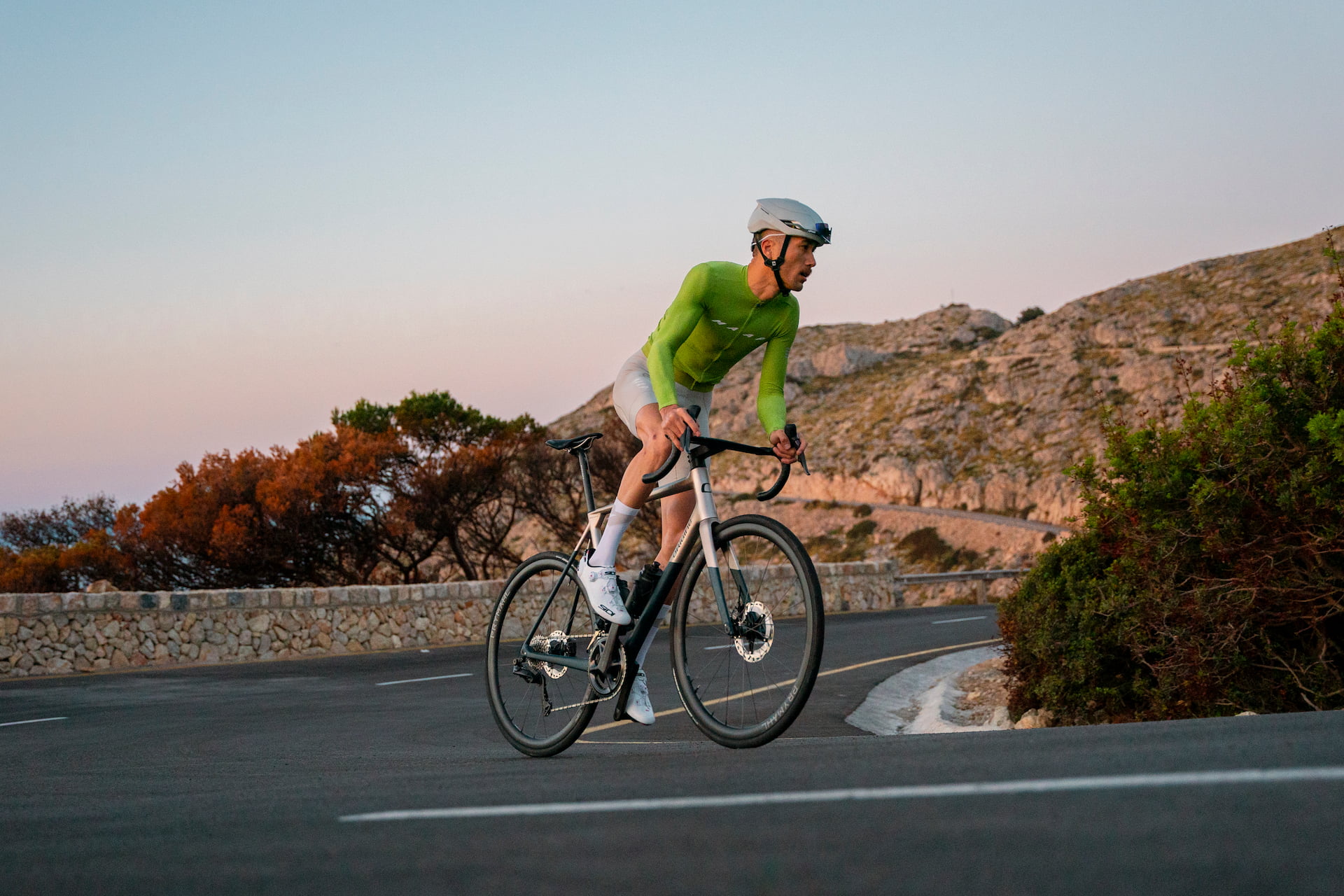L’Étape du Tour is a cycling event that allows amateurs to experience a day in the life of a Tour de France rider by covering a stage of the famous race. Preparation for this event is crucial, not only to finish the stage but also to fully enjoy the experience. Here is a detailed guide to preparing for L’Étape du Tour, including a specific training plan.
Before You Begin: Set Your Goals
The first step is to define your objectives. Do you simply want to finish the stage, improve your time compared to a previous participation, or rank among the top in your age category? Your goals will influence the structure and intensity of your training.
Base Assessment
Before starting the training plan, assess your current physical condition. It’s a good idea to perform an FTP (Functional Threshold Power) test to determine your functional threshold power. This will help you personalize the intensity zones of your training.
If you don’t have a power meter, a stress test can help define your different intensity zones based on your heart rate. Although slightly variable and less precise, it remains an excellent way to train at a lower cost.

Training Plan: 12 Weeks
Phase I
Weeks 1 to 4: Base Building
- Frequency: 3 to 4 rides per week.
- Type of Training: Focus on building an endurance base with long rides at low to moderate intensity. Add a weekly hill ride to start working on climbing power.
- Duration: Gradually increase the duration of long rides, starting from 2 hours and extending to 4 hours by the end of this phase.
Phase II
Weeks 5 to 8: Increasing Intensity
- Frequency: 4 to 5 rides per week.
- Type of Training: Introduce high-intensity intervals and threshold work. This includes short (1 to 5 minutes) high-intensity efforts and longer (10 to 20 minutes) moderate-intensity efforts.
- Example Session: After warming up, perform 4 to 6 repetitions of 5 minutes at threshold power, with 5 minutes of recovery between each.
Phase III
Weeks 9 to 12: Sharpening and Tapering
- Frequency: Reduce to 3 to 4 rides per week towards the end.
- Type of Training: Maintain one high-intensity session per week but gradually reduce training volume to arrive fresh on race day. Keep long rides but with less intensity.
- Tapering Strategy: Start significantly reducing training volume 2 weeks before the event, maintaining one high-intensity session to keep the rhythm.
Weekly Training Plan
Monday: Complete Rest
- Activity: No intense physical activity.
- Objective: Allow the body to fully recover from the previous week’s efforts.
- Tip: Practice light stretching or yoga to improve flexibility and promote recovery.
Tuesday: High-Intensity Intervals
- Duration: About 1 hour.
- Activity: After a 15-minute warm-up, perform 6 repetitions of 3 minutes at high intensity (90-95% of max HR), followed by 3 minutes of active recovery.
- Objective: Improve power and anaerobic capacity.
- Tip: Focus on maintaining a high cadence and good form during efforts.
Wednesday: Endurance Ride
- Duration: 2 hours.
- Activity: Ride at a moderate intensity (70-75% of max HR).
- Objective: Improve base endurance and active recovery after an intense session.
- Tip: Use this ride to practice nutrition and hydration as you would on race day.
Thursday: Hill Ride
- Duration: 1.5 hours.
- Activity: Include several short climbs (3-5 minutes) at high intensity. Focus on maintaining good climbing technique.
- Objective: Build climbing power and specific endurance.
- Tip: Choose hills with a similar gradient to those you will encounter during L’Étape du Tour.
Friday: Light Day or Rest
- Activity: Complete rest or very light ride of 30 to 45 minutes.
- Objective: Active recovery to prepare for the weekend’s training.
- Tip: Listen to your body; if you feel particularly tired, opt for complete rest.
Saturday: Long Ride with Threshold Efforts
- Duration: 3 to 4 hours.
- Activity: Include 2 to 3 blocks of 20 minutes at threshold power/pace, with 10 minutes of recovery between each block.
- Objective: Improve endurance and the ability to sustain intense effort over long periods.
- Tip: Ensure you stay well-hydrated and fueled during the ride.
Sunday: Recovery Ride
- Duration: 1 to 1.5 hours.
- Activity: Easy ride at low intensity (50-60% of max HR).
- Objective: Promote muscle recovery and reduce fatigue.
- Tip: Use this ride to release both physical and mental tension.
This weekly training plan is designed to effectively prepare you for the demands of L’Étape du Tour, developing power, endurance, and recovery capacity.

Nutrition and Hydration
Do not neglect your nutrition and hydration during preparation. A good diet and adequate hydration support training efforts and recovery. Also, practice your nutrition and hydration strategy during long sessions to avoid surprises on race day.
Rest and Recovery
Rest is as important as training. Make sure to include full rest days in your plan and use recovery techniques such as stretching, compression, and massage therapy.
Which Bike to Choose?
Road Bike, Mountain Comfort, or Gravel
The Axxome is designed for cyclists seeking high performance without sacrificing its core identity. With its new, even more efficient frame, the Axxome III is smooth and comfortable on a wider range of terrains.
Speed across smooth roads, conquer mountain passes, or glide over cobblestones: nothing will stop you. The impressive efficiency of the UML technology, previously used only for molding the front triangle on the Axxome Evo, is now utilized for the complete frame molding, including both the front and rear triangles. This gives the Axxome III even more lively and dynamic handling and improved vibration damping.
Transfer your watts even more effectively with the optimized Dynamic Response, and enjoy a more efficient pedal stroke on all types of surfaces.
Finally, for even more comfort, the Axxome now accommodates tires up to 35mm and integrates its cabling for increased safety, better handling, and easy maintenance.
Expand your playground and reinvent road cycling.
Easy Gears
For choosing gears, the ideal is to achieve a 1:1 ratio. This ratio means that the largest cog is as large as the smallest chainring (e.g., a small chainring with 34 teeth and an 11-34 cassette). This ratio allows for one wheel rotation per pedal turn. It’s a very soft gear for road riding, but if you’re tackling several thousand meters of elevation, you will be very grateful for it by the end of the ride.

The Course of L’Étape du Tour 2024
The 32nd edition of L’Étape du Tour de France will take place on July 6, 2024 (initially planned on July 7, but rescheduled because of the national election). It will follow the route of the 20th stage of the Tour de France, spanning from Nice to the Col de la Couillole over 138 km, with a total positive elevation gain of more than 4,600 meters. This course includes climbs of the Cols de Braus, Turini, Colmiane, and Couillole.
It is essential to prepare meticulously for this 2024 edition of L’Étape du Tour de France, which promises to be one of the most challenging compared to the previous 31 editions. With a total of 4,600 meters of positive elevation gain over 138 km, this race presents a true challenge that must be approached with optimal preparation.

Download the GPX file of theÉtape du Tour 2024 :
download here.
The Profile of the climbs for L’Étape: Nice – Col de la Couillole
Col de Braus (par L’escarene)

Col de Turini (par Sospel)

Col de la Colmiane (par Roquebillière)

Col de la Couillole (par Saint-Sauveur-sur-Tinée)

Frequently Asked Questions for Preparing for L’Étape du Tour
- When is the best time to start training for L’Étape du Tour?
It is recommended to begin your specific training at least 12 weeks before the event to allow for adequate progression through the different phases of training. This implies having a base and practicing at least once a week for an additional 2 or 3 months. - What type of bike is recommended for L’Étape du Tour?
A high-performance, lightweight, and well-maintained road bike is ideal. Ensure it is well-fitted to your body and in good mechanical condition. We recommend a lightweight road bike for mountainous terrain, such as the Axxome GTR. - How to manage nutrition during training?
It is crucial to consume complex carbohydrates, proteins, and healthy fats. During long training sessions, practice consuming gels, bars, and energy drinks that you plan to use on race day. Consider having salty foods in case you get tired of sweet flavors after several hours. - How many rest days should I take each week?
It is recommended to take at least one to two full rest days per week to allow your body to recover and strengthen. - What is the importance of group rides in preparation?
Group rides can improve your riding skills and get you used to riding in a peloton, which is useful given the large number of participants in L’Étape du Tour. Never compromise your safety. Take your time and maintain good safety distances, especially when overtaking, particularly on descents. - How to prevent injuries during training?
Make sure to include flexibility and strengthening exercises in your routine, stay hydrated, and listen to your body. Don’t push too hard on days when you feel tired or sore. If you experience pain, consult our cycling health articles and seek advice from a healthcare professional. - What is the importance of hill or altitude training for this race?
L’Étape du Tour takes place in the mountains, so hill training will be very beneficial. If you don’t live in a mountainous area, try to include as many hills as possible in your routes and find a pace you can maintain for a full hour. If this isn’t possible, connected home trainer workouts that simulate incline effects can help. Altitude also requires acclimatization. If you cannot prepare for it, remember to reduce your effort thresholds above 1500 meters. - Do I need a coach to prepare for L’Étape du Tour?
While not mandatory, a coach can personalize your training plan, motivate you, and help you manage the technical and tactical aspects of the race. The training plan provided above is a good base for progressing and giving yourself the best chances of success in your cyclosportive. - How do I know if I am ready for the race?
If you can comfortably complete long training sessions that simulate the distance and profile of the stage, and have followed your training plan, you are likely ready. - What to do in the last days before L’Étape du Tour?
The last days should be devoted to rest and recovery. Decrease the volume of your training, stay well-hydrated, eat balanced meals, and mentally and materially prepare everything you will need for the race.



![[Guide] How to Get Started in Ultra-Cycling ?](https://cyclisthouse.origine-cycles.com/wp-content/uploads/2021/12/BikingMan-x-Origine-Cycles-1_adobespark-400x250.jpeg)
